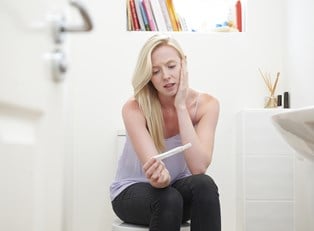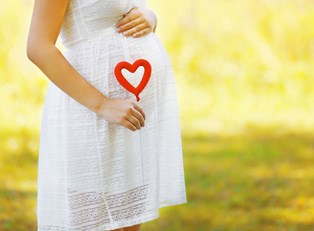Sore, Tender Breasts
Shortly after conception, the entire breasts, including the nipples, become sore and tender. This is due to the shift in hormones that is occurring as your body. This will occur one to three weeks following conception. The breasts swell up during the initial stages of pregnancy as the breasts start the process of producing milk.
Missing Your Period
In most cases, sexually active women who miss a period become suspicious of pregnancy. Missing a period is one of the first signs of pregnancy in women. If you have irregular cycles, you may not be too alarmed. However, if you have a regular cycle, missing your period should definitely prompt you either to purchase a pregnancy test or to visit a doctor's office.
Nausea and Morning Sickness
Nausea is very common very early in the pregnancy. This nauseous feeling is generally referred to as 'morning sickness' but the feeling actually occurs throughout the day. As early as one week following conception, an expecting mother may experience nausea and vomiting.
Extreme Fatigue All Day Long
Initially when a woman conceives, she will likely feel exhausted. This is because there are many changes going on inside of the body that are causing her to feel both tired and lazy. Hormones are shifting, body chemistry is changing rapidly. This zaps the expecting mom of most of her energy. This feeling generally occurs throughout the first trimester while the body is drastically adjusting to growing and carrying a baby.
Spotting or Cramping
Mild spotting and cramping generally occurs around the time of the menstrual cycle. This is due to the fertilized embryo latching onto the uterus. Not all women will experience spotting, but many do. Cramping may occur during this time as well. Slight cramping may occur for a few weeks as the uterus repositions itself to accommodate the baby.
Darker and Wider Areolas
You may find that your areolas become darker around the time of your period. The areola will also become a bit wider as your breasts spread out. As your areolas spread, you may notice tiny bumps scattered around the areola. There is no need to be alarmed about this change; the breasts are changing and preparing to breastfeed the baby.
Frequent Urination
You will also notice that you are urinating more frequently. This is because the growing uterus is putting pressure on your bladder. As the baby grows, the pressure on the bladder will decrease since the uterus will lift up. However, you will have a need to urinate quite frequently during the first 6 to 8 weeks following conception.
Rise in Body Temperature
Your basal body temperature will become elevated after conception. This is due to the release of HCG. HCG is a hormone that is released about one week to twelve days after conception. The hormone is released after the fertilized egg goes through the fallopian tube and latches onto the uterus. The rise in temperature is due to the body detecting that the woman is pregnant.
Other Common Changes In Women During Pregnancy
Aches, pains, and general soreness during the initial weeks of pregnancy are common as well. In addition, women tend to get slightly more emotional than usual due to changes in hormone levels. Headaches may occur during the first two to four weeks as well. These can be very mild and have been known to be quite intense. The headaches are also a reaction to the changes occurring in the body shortly after conception (www.americanpregnancy.org.)
A change in bowels also may occur. The excess hormones in the body will cause the bowels to work less efficiently for the first few weeks of pregnancy. Other symptoms include thirst, cravings for certain foods, and an aversion to certain foods.
When experiencing the signs mentioned above, it is important to take a pregnancy test early on. You can visit your doctor's office or take a home pregnancy test. The doctor can do a blood or urine test to check for pregnancy. Home pregnancy tests use a urine sample to check for the HCG hormone, and are often accurate 10 days or more after the egg has been fertilized.



